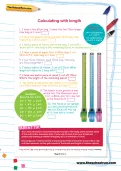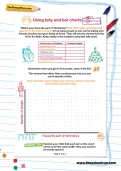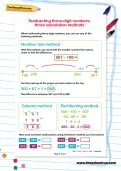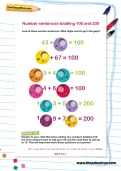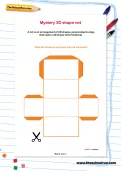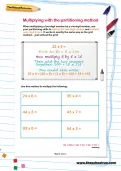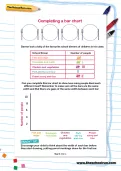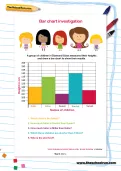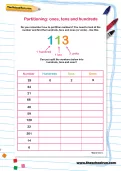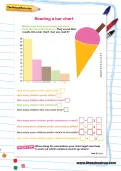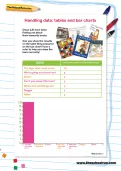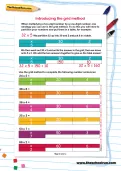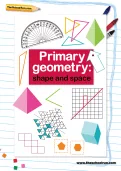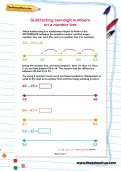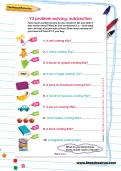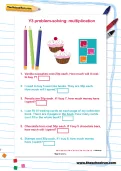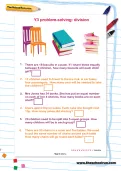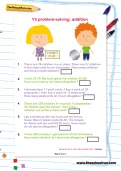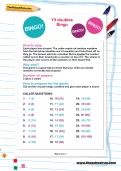Year 3 Maths worksheets
Free worksheets: Weights and measurements, KS2, Y3
You’ll need to login or Register first to access these worksheets for free.
Once you’ve tried out our free worksheets, why not explore all our resources (1000s of worksheets, interactive tutorials, learning packs and more) with a 14-day FREE trial subscription.
Calculating with length
Ready for some calculations with length? Rulers at the ready...
Using tally and bar charts
What’s your favourite part of Christmas? Find information about the best aspects of the festive season for as many people as you can by asking your friends at school and your family at home. They will need to choose from the list in the table. Keep a tally of the numbers using this tally chart. Now use these axes to draw your own bar chart to show the information you have found.
Subtracting three-digit numbers
When subtracting three-digit numbers, there are three different methods you can use. Work out these subtractions using whichever method you find easiest.
Number sentences totalling 100 and 200
Look at these number sentences. What digits need to go in the gaps? Remember when adding two numbers totalling 100, the tens numbers have to add up to 90 and the units have to add up
to 10.
to 10.
Mystery 3D shape net
A net is an arrangement of 2D shapes, joined edge to edge, that make a 3D shape when folded up. What 3D shape do you think this net will make?
Multiplying with the partitioning method
When multiplying a two-digit number by a one-digit number, use your partitioning skills to split up the two-digit number and multiply each digit in turn. It works in exactly the same way as the grid method… just without the grid! Use this method to multiply these numbers.
Horizontal and vertical lines
Horizontal lines are lines that go across. Vertical lines are lines that go up and down. How many horizontal lines does this shape have? How many vertical lines does it have? How many right angles does it have? Can you explain what a right angle is? Remember that the corner of a sheet of paper or book is a right angle.
Completing a bar chart
Darren took a tally of the favourite school dinners of children in his class. Can you complete this bar chart to show how many people liked each different meal? Remember to make sure all the bars are the same width and that there are gaps of the same width between each bar. Think about the width of each bar before you start drawing, putting pencil markings down for the first bar.
Bar chart investigation
A group of children in Diamond Class measured their heights and drew a bar chart to show their results. 1. Which child is the tallest? 2. How much taller is Rachel than Susan? 3. How much taller is Millie than Katie? 4. Which three children are shorter than 130cm? 5. Who is the shortest?
Partitioning: ones, tens and hundreds
Do you remember how to partition numbers? You need to look at the number and find the hundreds, tens and ones (or units). Can you split the numbers below into hundreds, tens and ones?
Reading a bar chart
Maple class have been finding out about favourite ice-cream flavours. They’ve put their results into a bar chart. Can you read it?
Handling data: tables and bar charts
Class 2JE have been finding out about their favourite books. Can you show the results on the table they prepared on the bar chart? Use a ruler to help you draw the bars correctly!
Introducing the grid method
The grid method for multiplication is taught in KS2 to help children multiply two-digit numbers by one- and two-digit numbers using their partitioning skills. Review the method and put it into practice with our explanatory worksheet.
Primary geometry: shape and space
Do you know your hexagons from your heptagons, your pentagonal pyramids from your octagonal prisms? From 2D shapes to angles and symmetry our seventy-page Primary Geometry: shape and space learning pack covers all aspects of the national curriculum (Shape and Space) and will ensure your child can use a protractor, translate a shape and look for a mirror line. Challenge them to a game of 3D shape dominoes, make a right-angle measurer and get started!
Subtracting two-digit numbers on a number line
When subtracting it is sometimes helpful to think of the DIFFERENCE between the smaller number and the larger number. You can work this out on a number line. Try using a number line to work out these questions. (Remember to jump to the next tens number first and then keep jumping in tens.)
Y3 problem-solving: subtraction
Use your subtraction skills to answer these questions. How quickly can you finish them all?
Y3 problem-solving: multiplication
How good are you at multiplication? Test your skills with these tricky word problems.
Y3 problem-solving: all four operations
Look at these problems and think about whether you need to add, subtract, multiply or divide. Can you write out the calculation? `draw diagrams if you get stuck.
Y3 problem-solving: addition
Use this teacher-created worksheet to help your Year 3 child practise their problem-solving skills with addition. Can you solve these tricky word problems using your addition skills?
Y3 doubles Bingo
Each player has a board. The caller reads out random numbers from the list below (doubles are in brackets) and ticks them off as they go. The person who has a number that is double the number called out on their board puts a counter on top of it. The winner is the player who covers all the numbers on their board first.
